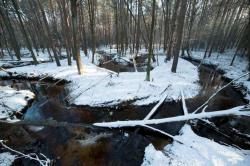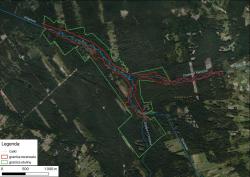 Asset Publisher
Asset Publisher
Polish forests
Poland is in the European lead, while concerning the area of all forests. They cover about 29,2 % of the country territory, and grow within the area of 9,1 million hectares. The overwhelming majority of the forests is state owned, of which almost 7,6 million hectares are managed by the State Forests National Forest Holding..
The number of Polish forest is still growing. The forestation rate of the country has increased from 21 % in 1945 to 29,2 % at the moment. Between 1995 and 2008, the forest area increased by 310 thousand ha. The basis for afforestation works is the "National Programme for Increasing the Forest Cover" (KPZL), assuming an increase of the forestation rate up to 30 % by 2020 and up to 33 % by 2050. Polish forests abound in flora, fauna and fungi. 65 % of the total number of animal species live there.
The forests grow in our country on poor soils, mainly because of the development of the agriculture in previous years. It influences the distribution of the types of the forest sites in Poland. Over 55 % of the forest areas is covered with coniferous forests. In other areas, there are forest sites, mainly the mixed ones. Their small part constitute alder and riparian forests – not more than 3 %.
In the years 1945 – 2011 the area of natural deciduous tree stands within the area of the State Forests National Forest Holding increased from 13 to 28,2 %.
Within the lowlands and uplands the most often occurring tee species is pine. It covers 64,3 % of the forest area of the State Forests National Forest Holding and 57,7 % of private and commune forests. In the mountains the predominant species is European spruce ( in the west) and European spruce with beech (in the east). Domination of pine is the result of carrying on sustainable forest management in the past. Once, the monocultures (crops or cultivations of one species) were the answer to the great demand of industry for wood. Such forests appeared to be quite fragile to climatic factors. They also were often the prey of pests' expansion.
In Polish forests, the share of other tree species, especially deciduous trees have been systematically increasing. The foresters have stepped aside from monocultures – that is why, they try to fit specific species of the forest stand to the natural stand, that would be proper for the given area. Thanks to that, in the years 1945 – 2011, the area of the deciduous tree stands within the lands of the State Forests National Forest Holding increased from 13 to 28,2 %. There occur more and more frequently the following tree species: oaks, ashes, maples, sycamore maples, elms, but also birches, beeches, alders, poplars, hornbeams, aspens, tilias and willows.
Our forests are the most often represented by the forest stands aged 40 to 80 years. The average age of the forest equals 60 years. More and more trees are of big size at the age over 80 years. Since the end of the Second World War, the forests' area has increased up to almost 1,85 million hectares.
Raport o stanie lasów w Polsce 2012
 Asset Publisher
Asset Publisher
 Asset Publisher
Asset Publisher
Nowy rezerwat w granicach RDLP w Lublinie
Nowy rezerwat w granicach RDLP w Lublinie
 Meandry Smarkatej, fot. wolnerzeki.pl
Meandry Smarkatej, fot. wolnerzeki.pl
 Rezerwat przyrody Dolina Smarkatej-wraz-z-otuliną - fot. wolnerzeki.pl
Rezerwat przyrody Dolina Smarkatej-wraz-z-otuliną - fot. wolnerzeki.pl
Do 76 wzrosła liczba rezerwatów przyrody na terenie lubelskiej dyrekcji LP. 2 kwietnia br. powołano do życia „Dolinę Smarkatej” – nowy tego typu obszar chroniony zlokalizowany w leśnych ostępach Nadleśnictwa Nowa Dęba.
Zarządzenie w tej sprawie podpisał Regionalny Dyrektor Ochrony Środowiska w Rzeszowie, a w świetle prawa stanie się on „pełnoprawnym” rezerwatem po upływie 14 dni od publikacji aktu w Dzienniku Urzędowym Województwa Podkarpackiego.
Rezerwat „Dolina Smarkatej” jest położony w Puszczy Sandomierskiej, na terenie gmin Cmolas i Majdan Królewski w powiecie kolbuszowskim. Geneza jego powstania wiąże się z nazwą niewielkiej, choć niezwykle urokliwej rzeki Smarkata będącej jedną z ostatnich dzikich, nieuregulowanych rzek, które przepływają przez północną część Kotliny Sandomierskiej. Na uwagę zasługuje jej meandrujące koryto, w którym dosyć powszechnym widokiem są zalegające pnie drzew, a także bobrowe tamy i rozlewiska. O szczególnych walorach przyrodniczych tego terenu świadczą również liczne starorzecza nazywane przez lokalnych mieszkańców „smarkaczyskami”, cenne torfowiska niskie oraz chronione i rzadkie gatunki roślin i zwierząt. Głównym inicjatorem powstania tej formy ochrony przyrody położonej w granicach Nadleśnictwa Nowa Dęba oraz Nadleśnictwa Mielec (RDLP w Krośnie) było Podkarpackie Towarzystwo Przyrodników Wolne Rzeki.
–Nowoutworzony rezerwat znajdował się na liście stu rezerwatów przyrody, których utworzenie poparły Lasy Państwowe, chcąc uczcić w ten sposób okazały jubileusz stulecia naszej instytucji (więcej o idei w artykule 100 rezerwatów na 100-lecie LP). Ochrona rezerwatowa na tym terenie przyczyni się do zachowania cennych mokradeł oraz wysokiej różnorodności biologicznej. Cieszymy się, że lubelska dyrekcja LP zyskuje kolejny obszar chroniony, co potwierdza, że nasze lasy cechują się dużą różnorodnością i bogactwem przyrodniczym – zaznacza Mariusz Kiczyński, zastępca dyrektora RDLP w Lublinie ds. gospodarki leśnej.
Więcej informacji o walorach nowopowstałego rezerwatu przyrody można znaleźć w materiale Telewizji Lokalnej Tarnobrzeg – „Dolina Smarkatej - perła Puszczy Sandomierskiej”.
Przypomnijmy, że ostatnim rezerwatem przyrody utworzonym w granicach lubelskiej dyrekcji LP był rezerwat „Sugry” im. Janusza Szostakiewicza, powołany do życia w 2021 roku w lasach Nadleśnictwa Chotyłów, o którym pisaliśmy tutaj. Łącznie na obszarze Regionalnej Dyrekcji Lasów Państwowych w Lublinie znajduje się 76 rezerwatów przyrody, które zajmują powierzchnię nieco ponad 10 tys. ha, z czego aż 4,3 tys. ha stanowi 6 rezerwatów położonych w Lasach Janowskich, w granicach Nadleśnictwa Janów Lubelski.


 fot. Paweł Fabijański
fot. Paweł Fabijański
 fot. Paweł Fabijański
fot. Paweł Fabijański
 fot. Paweł Fabijański
fot. Paweł Fabijański




